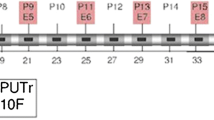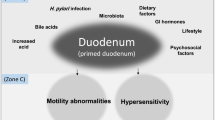Abstract
Alterations of small intestinal sensory thresholds and small intestinal dysmotility are associated with functional dyspepsia. Because gastric and duodenal afferents partly project to the same areas, we postulated that patients with functional dyspepsia andH. pylori infection would be characterized by lower duodenal sensory thresholds. We evaluated 16 patients with functional dyspepsia and 16 age- and sex-matched controls. All patients had undergone an extensive diagnostic work-up to exclude organic lesions. Mechanosensitive function was tested in the third portion of duodenum utilizing a barostat device, and small intestinal motility was assessed before and during duodenal nutrient infusion with a five-channel low-compliance perfusion system.H. pylori status was assessed by a validated serological test. Small intestinal sensory thresholds (first perception and maximal tolerated pressure) were significantly lower in patients (21.1±2.1 and 30.9±1.8 mm Hg) compared to controls (33.0±2.2 and 38.8±0.9 mm Hg, allP<0.003). Nine of 16 patients compared with five of 16 controls wereH. pylori positive (P=0.15). Thresholds forH. pylori-negative (28.7±2.8 and 36.5±1.1 mm Hg) or -positive subjects (25.0±3.0 and 32.7±2.4 mm Hg) were overall not significantly different (P>0.3). However, in patients with defined highH. pylori titers (>50 units/ml) defineda priori, thresholds for first perception were significantly lower (14.7±2.9 mm Hg,N=5) compared to patients withH. pylori titers below this threshold (24.3±2.9 mm Hg,N=4) or withoutH. pylori infection (23.8±3.4 mm Hg,P<0.05). During duodenal nutrient infusion, the duodenal motility index increased (P<0.03). This increase was not significantly different in patients and controls or inH. pylori-negative and -positive subjects. Sensory abnormalities are present in patients with functional dyspepsia. In a small subgroup of patients with highH. pylori titers, sensory abnormalities may be linked toH. pylori infection.
Similar content being viewed by others
References
Nyrén O: Functional dyspepsia: Is gastric acid and/orHelicobacter pylori infection involved in the aetiology? Eur J Gastroenterol Hepatol 4:608–614, 1992
Stanghellini V, Maccarini MR, Barbara G, Jadallah K, Cioffi G, Ferri A: The relationship between functional dyspepsia andHelicobacter pylori infection. Eur J Gastroenterol Hepatol 5:S64-S66, 1993
Talley NJ: A critique of therapeutic trials inHelicobacter pylori-positive functional dyspepsia. Gastroenterology 106:1174–1183, 1994
Rokkas T, Pursey C, Uzoechina E, et al:Campylobacter pylori and non-ulcer dyspepsia. Am J Gastroenterol 82:1149–1152, 1987
Strauss RM, Wang TC, Kelsey PB, et al: Association ofHelicobacter pylori infection with dyspeptic symptoms in patients undergoing gastroduodenoscopy. Am J Med 89:464–469, 1990
Bernersen B, Johnsen R, Bostad L, Straume B, Sommer AI, Burhol PG: IsHelicobacter pylori the cause of dyspepsia? BMJ 304:1276–1279, 1992
Holtmann G, Goebell H, Holtmann M, Talley NJ: Dyspepsia in healthy blood donors: Pattern of symptoms and association withHelicobacter pylori. Dig Dis Sci 39:1090–1098, 1994
Agreus L, Engstrand L, Svärdsudd K, Nyren O, Tibblin G:Helicobacter pylori seropositivity among swedish adults with and without abdominal symptoms. Scand J Gastroenterol 30:752–757, 1995
Frommer DJ, Carrick J, Lee A, Hazell SL: Acute presentation ofCampylobacter pylori gastritis. Am J Gastroenterol 83:1168–1171, 1988
Morris A, Nicholson G: Ingestion ofCampylobacter pyloridis causing gastritis and raised fasting pH. Am J Gastroenterol 82:192–199, 1987
Czinn SJ, Bertram TA, Murray PD, Yang P: Relationship between gastric inflammatory response and symptoms in patients infected withHelicobacter pylori. Scand J Gastroenterol Suppl 181:33–37, 1991
Johnson R, Bernersen B, Straume B, Forde OH, Bostad L, Burhol PG: Prevalences of endoscopic and histological findings in subjects with and without dyspepsia. BMJ 302:749–752, 1991
George AA, Tsuchiyose M, Dooley CP: Sensitivity of the gastric mucosa to acid and duodenal contents in patients with nonulcer dyspepsia. Gastroenterology 101:3–6, 1991
Lemann M, Dederding JP, Flourie B, Franchisseur C, Rambaud JC, Jian R: Abnormal perception of visceral pain in response to gastric distension in chronic idiopathic dyspepsia. The irritable stomach syndrome. Dig Dis Sci 36:1249–1254, 1991
Bradette M, Parc P, Douville P, Morin A: Visceral perception in health and functional dyspepsia. Crossover study of gastric distension with placebo and domperidone. Dig Dis Sci 36:52–58, 1991
Mearin F, Cucala M, Azpiroz F, Malagelada JR: The origin of symptoms on the brain-gut axis in functional dyspepsia. Gastroenterology 101:999–1006, 1991
Coffin B, Azpiroz F, Guarner F, Malagelada JR: Selective gastric hypersensitivity and reflex hyporeactivity in functional dyspepsia. Gastroenterology 107:1345–1351, 1994
Holtmann G, Goebell H, Talley NJ: Impaired small intestinal peristaltic reflexes and sensory thresholds are independent functional disturbances in patients with chronic unexplained dyspepsia. Am J Gastroenterol 91:485–491, 1996
Greydanus MP, Vassallo M, Camilleri M, Nelson DK, Hanson RB, Thomforde GM: Neurohormonal factors in functional dyspepsia: insights on pathophysiological mechanisms. Gastroenterology 100:1311–1318, 1991
Kellow JE, Eckersley CM, Jones MP: Enhanced perception of physiological intestinal motility in the irritable bowel syndrome. Gastroenterology 101:1621–1627, 1991
Rao SSC, Read NW, Davison PA, Bannister JJ, Holdsworth CD: Anorectal sensitivity and responses to rectal distention in patients with ulcerative colitis. Gastroenterology 93:1270–1275, 1987
Mayer EA, Gebhart GF: Basic and clinical aspects of visceral hyperalgesia. Gastroenterology 107:271–293, 1994
Mayer EA, Raybould HE: Role of visceral afferent mechanisms in functional bowel disorders. Gastroenterology 99:1688–1704, 1990
Andrews PLR. Vagal afferent innervation of the gastrointestinal tract. Prog Brain Res 67:65–86, 1986
Grundy D, Scratcherd T: Sensory afferents from the gastrointestinal tract.In Handbook of Physiology, Section 6, The Gastrointestinal System. Volume 1, Motility and Circulation, Part 1. JD Wood (ed). Bethesda, American Physiological Society, 1989, pp 593–620
Houpt KA: Gastrointestinal factors in hunger and satiety. Neurosci Biobehav Rev 6:145–164, 1980
Holtmann G, Guerra G, Hüber J, Goebell H, Talley NJ: Perception of gastric balloon distension: Does the distension protocol affect the perception threshold? Gastroenterology 106:A511, 1994
Azpiroz F, Malagelada JR: Physiological variations in canine gastric tone measured by an electronic barostat. Am J Physiol 248:G229-G237, 1985
Blaser MJ, Duncan DJ: Human serum antibody response toCampylobacter jejuni infection as measured in an enzyme linked immunoabsorbent assay. Infect Immun 33:292–298, 1984
Talley NJ, Newell DG, Ormand JE, et al: Serodiagnosis ofHelicobacter pylori: Comparison of enzyme-linked immunosorbent assay. J Clin Microbiol 29:1635–1639, 1991
Holtmann G, Goebell H, Holtmann M, Gschossmann J, Hüber J, Talley NJ:H. pylori and functional dyspepsia: Increased serum antibodies an independent risk factor. Gastroenterology 108:A116, 1995
SAS Institute Inc. SAS/STAT User's Guide, Release 6.03. Cary, North Carolina, SAS Institute Inc., 1988
Waldron B, Cullen PT, Kumar R, et al: Evidence for hypomotility in non-ulcer dyspepsia: A prospective multifactorial study. Gut 32:246–251, 1991
Malagelada JR, Stanghellini V: Manometric evaluation of functional upper gut symptoms. Gastroenterology 88:1223–1231, 1985
Holtmann G, Hüber J, Fischer H, Fleiter B, Goebell H, Talley NJ: Functional dyspepsia: A sensory duodenal defect with impaired intestino-intestinal reflexes. Gastroenterology 106:A511, 1994
Goh KL, Parasakthi N, Peh SC, Wong NW, Lo YL, Puthucheary SD:Helicobacter pylori infection and non-ulcer dyspepsia: The effect of treatment with colloidal bismuth subcitrate. Scand J Gastroenterol 26:1123–1131, 1991
Sengupta JN, Saha JK, Goyal RK: Differential sensitivity to bradykinin of esophageal distension-sensitive mechanoreceptors in vagal and sympathetic afferents of the opossum. J Neurophysiol 68:1053–1067, 1992
Hölzer HH, Raybould HE: Vagal and splanchnic sensory pathways mediate inhibition of gastric motility induced by duodenal distension. Am J Physiol 262:G603-G608, 1992
Sorkin LS: Nociceptive transmission within the spinal cord. Mount Sinai J 58:208–216, 1991
Grundy D, Scratcherd T: Sensory afferents from the gastrointestinal tract.In Handbook of Physiology. SG Schultz, JD Wood, BB Rauner (eds). New York, Oxford University Press, 1989, pp 593–620
Cottrell DF, Iggo A: Tension receptors with vagal afferent fibers in the proximal duodenum and pyloric sphincter of sheep. J Physiol 354:457–475, 1984
Mearin F, DeRibot X, Balboa A, et al: DoesHelicobacter pylori infection increase gastric sensitivity in functional dyspepsia? Gut 37:47–51, 1995
Stanghellini V, Ghidini C, Maccarini MR, Paparo GF, Corinaldesi R, Barbara L: Fasting and postprandial gastrointestinal motility in ulcer and non-ulcer dyspepsia. Gut 33:184–190, 1992
Pieramico O, Ditschuneit H, Malfertheiner P: Gastrointestinal motility in patients with non-ucler dyspepsia: A role forHelicobacter pylori infection? Am J Gastroenterol 88:364–368, 1993
Wegener M, Börsch G, Schaffstein J, Schulz Flake C, Mai U, Leverkus F: Are dyspeptic symptoms in patients withCampylobacter pylori-associated type B gastritis linked to delayed gastric emptying? Am J Gastroenterol 83:737–740, 1988
Qvist N, Rasmussen L, Axelsson CK:Helicobacter pylori-associated gastritis and dyspepsia: The influence on migrating motor complexes. Scand J Gastroenterol 29:133–137, 1994
Author information
Authors and Affiliations
Additional information
Supported by a grant from Deutsche Forschungsgemeinschaft, grant number Ho 1193/3-1,2 and by the Gastrointestinal Motility Research Award from the German Association of Digestive Diseases (donated by the Janssen Research Foundation).
Rights and permissions
About this article
Cite this article
Holtmann, G., Talley, N.J. & Goebell, H. Association betweenH. pylori, duodenal mechanosensory thresholds, and small intestinal motility in chronic unexplained dyspepsia. Digest Dis Sci 41, 1285–1291 (1996). https://doi.org/10.1007/BF02088548
Received:
Revised:
Accepted:
Issue Date:
DOI: https://doi.org/10.1007/BF02088548




